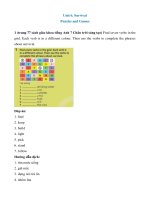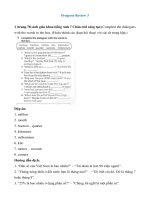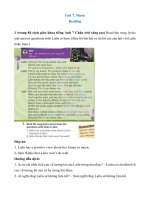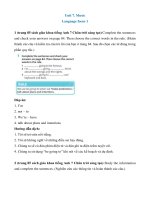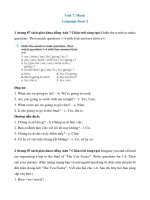x0016 part morebook vn 3763
Bạn đang xem bản rút gọn của tài liệu. Xem và tải ngay bản đầy đủ của tài liệu tại đây (145.79 KB, 7 trang )
Introduction to C#
The New Language for
H.Mössenböck
University of Linz, Austria
.
Contents
Introduction to C#
1.
2.
3.
4.
5.
6.
Overview
Types
Expressions
Declarations
Statements
Classes and Structs
Advanced C#
7. Inheritance
8. Interfaces
9. Delegates
10. Exceptions
11. Namespaces and Assemblies
12. Attributes
13. Threads
14. XML Comments
References:
• B.Albahari, P.Drayton, B.Merrill: C# Essentials. O'Reilly, 2001
• S.Robinson et al: Professional C#, Wrox Press, 2001
• Online documentation on the .NET SDK CD
2
Features of C#
Very similar to Java
70% Java, 10% C++, 5% Visual Basic, 15% new
As in Java
As in C++
•
•
•
•
•
•
•
•
•
•
• (Operator) Overloading
• Pointer arithmetic in unsafe code
• Some syntactic details
Object-orientation (single inheritance)
Interfaces
Exceptions
Threads
Namespaces (like Packages)
Strong typing
Garbage Collection
Reflection
Dynamic loading of code
...
3
New Features in C#
Really new (compared to Java)
"Syntactic Sugar"
•
•
•
•
•
•
•
• Component-based programming
- Properties
- Events
• Delegates
• Indexers
• Operator overloading
• foreach statements
• Boxing/unboxing
• Attributes
• ...
Reference and output parameters
Objects on the stack (structs)
Rectangular arrays
Enumerations
Unified type system
goto
Versioning
4
Hello World
File Hello.cs
using System;
class Hello {
static void Main() {
Console.WriteLine("Hello World");
}
•
•
•
•
uses the namespace System
entry point must be called Main
output goes to the console
file name and class name
need not be identical
}
Compilation (in the Console window)
csc Hello.cs
Execution
Hello
5
Conversion Operators
Implicit conversion
-
If the conversion is always possible without loss of precision
e.g. long = int;
Explicit conversion
-
If a run time check is necessary or truncation is possible
e.g. int = (int) long;
Conversion operators for custom types
class Fraction {
int x, y;
...
public static implicit operator Fraction (int x) { return new Fraction(x, 1); }
public static explicit operator int (Fraction f) { return f.x / f.y; }
}
Use
Fraction f = 3;
int i = (int) f;
// implicit conversion, f.x == 3, f.y == 1
// explicit conversion, i == 3
64
Nested Types
class A {
int x;
B b = new B(this);
public void f() { b.f(); }
public class B {
A a;
public B(A a) { this.a = a; }
public void f() { a.x = ...; ... a.f(); }
}
}
class C {
A a = new A();
A.B b = new A.B(a);
}
For auxiliary classes that should be hidden
- Inner class can access all members of the outer class (even private members).
- Outer class can access only public members of the inner class.
- Other classes can access an inner class only if it is public.
Nested types can also be structs, enums, interfaces and delegates.
65
